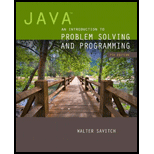
Explanation of Solution
Comparison of “int” variables:
If “x1” and “x2” are two variables of type “int”, then the values of the variables are compared as “x1 == x2”.
Example:
//Import necessary header files
import java.util.*;
//Define the class
class Main
{
//Define the main() method
public static void main(String[] args)
{
//Initialize the variables
int x1 = 10;
int x2 = 10;
//Check the condition
if(x1 == x2)
{
//True, print the statement
System...
Explanation of Solution
Comparison of “int” variables:
- • If “x1” and “x2” are two variables of type “string”, then the values of the variables are compared as “x1.equals(x2)”.
- ○ The method “equals()” mention the operator “= =”.
- ○ It always returns the Boolean values, it doesn’t throw any exception.
Example:
//Import necessary header files
import java.util.*;
//Define the class
class Main
{
//Define the main() method
public static void main(String[] args)
{
//Initialize the string variables
String x1 = "10"
String x2 = "10"
//Check the condition
if(x1.equals(x2))
{
//True, print the statement
System...
Want to see the full answer?
Check out a sample textbook solution
Chapter 3 Solutions
Java: An Introduction to Problem Solving and Programming (7th Edition)
- Correct answer will be upvoted else downvoted. Computer science. You are given a positive integer x. Check whether the number x is representable as the amount of the solid shapes of two positive integers. Officially, you really want to check in case there are two integers an and b (1≤a,b) to such an extent that a3+b3=x. For instance, in the event that x=35, the numbers a=2 and b=3 are reasonable (23+33=8+27=35). In the event that x=4, no pair of numbers an and b is reasonable. Input The primary line contains one integer t (1≤t≤100) — the number of experiments. Then, at that point, t experiments follow. Each experiment contains one integer x (1≤x≤1012). Kindly note, that the input for some experiments will not squeeze into 32-cycle integer type, so you should use something like 64-bit integer type in your programming language. Output For each experiment, output on a different line: "Indeed" in case x is representable as the amount of the 3D shapes of two…arrow_forwardwrite another function drawLine(int x, int y) in the above code. this function should return length of lines by same method i.e., subtracting y from x.arrow_forwardWhere is the variable F? Why it is not there?arrow_forward
- hi! i am a newbie in python. please help me on this problem. also, please send a screenshot for a proof that the codes works. thanks~arrow_forwarduestion 42: Return whether a string consists of a single letter In the function below, return True if the input string parameter consists of a single uppercase letter; otherwise, return False. Most solutions would do this in two logical steps: first testing if the string consists of a single character and, second, testing whether that character is one of the uppercase letters (which can be done by seeing if it is alphabetically between A and Z, inclusive).arrow_forwardHas anybody tried most of the string methods, yet in interactive modearrow_forward
- hello. can you solve it? thank you...arrow_forwardJava Program with try againarrow_forwardBartleby answered my homework and Write a function called has_duplicates that takes a string parameter and returns True if the string has any repeated characters. Otherwise, it should return False. Implement has_duplicates by creating a histogram using the histogram function above. Do not use any of the implementations of has_duplicates that are given in your textbook. Instead, your implementation should use the counts in the histogram to decide if there are any duplicates. Write a loop over the strings in the provided test_dups list. Print each string in the list and whether or not it has any duplicates based on the return value of has_duplicates for that string. For example, the output for "aaa" and "abc" would be the following. aaa has duplicatesabc has no duplicates Print a line like one of the above for each of the strings in test_dups. True needs to be defined. I tried to code it but didn't accept and got an error message.arrow_forward
- Write a program that does two string functions: capitalize the first word of a phrase, and reverse the letters of words in odd positions within the phrase. For this program it is acceptable to let punctuation be part of the word. Write a capitalizeWords() and a reverseOddWords() method and call them in a test program. Make certain to properly handle empty phrases, phrases with one and two words, and phrases with greater than two words. For example, if the original phrase were: Learning Java is fun! Java is powerful and easy to use The capitalized version would be: Learning Java Is Fun! Java Is Powerful And Easy To Use And with reversed odd words would be: gninraeL Java sI Fun! avaJ Is lufrewoP And ysaE To esUarrow_forwardUse Java.arrow_forwardWrite a function that takes a String and checks whether or not it ends with one of "T", *?.", or *" Return true if it does, otherwise false. Try writing your solution using regular String methods and again as a RegExp Using your solution, do a check on the following sentences: a sentence ending with!arrow_forward
 Database System ConceptsComputer ScienceISBN:9780078022159Author:Abraham Silberschatz Professor, Henry F. Korth, S. SudarshanPublisher:McGraw-Hill Education
Database System ConceptsComputer ScienceISBN:9780078022159Author:Abraham Silberschatz Professor, Henry F. Korth, S. SudarshanPublisher:McGraw-Hill Education Starting Out with Python (4th Edition)Computer ScienceISBN:9780134444321Author:Tony GaddisPublisher:PEARSON
Starting Out with Python (4th Edition)Computer ScienceISBN:9780134444321Author:Tony GaddisPublisher:PEARSON Digital Fundamentals (11th Edition)Computer ScienceISBN:9780132737968Author:Thomas L. FloydPublisher:PEARSON
Digital Fundamentals (11th Edition)Computer ScienceISBN:9780132737968Author:Thomas L. FloydPublisher:PEARSON C How to Program (8th Edition)Computer ScienceISBN:9780133976892Author:Paul J. Deitel, Harvey DeitelPublisher:PEARSON
C How to Program (8th Edition)Computer ScienceISBN:9780133976892Author:Paul J. Deitel, Harvey DeitelPublisher:PEARSON Database Systems: Design, Implementation, & Manag...Computer ScienceISBN:9781337627900Author:Carlos Coronel, Steven MorrisPublisher:Cengage Learning
Database Systems: Design, Implementation, & Manag...Computer ScienceISBN:9781337627900Author:Carlos Coronel, Steven MorrisPublisher:Cengage Learning Programmable Logic ControllersComputer ScienceISBN:9780073373843Author:Frank D. PetruzellaPublisher:McGraw-Hill Education
Programmable Logic ControllersComputer ScienceISBN:9780073373843Author:Frank D. PetruzellaPublisher:McGraw-Hill Education





